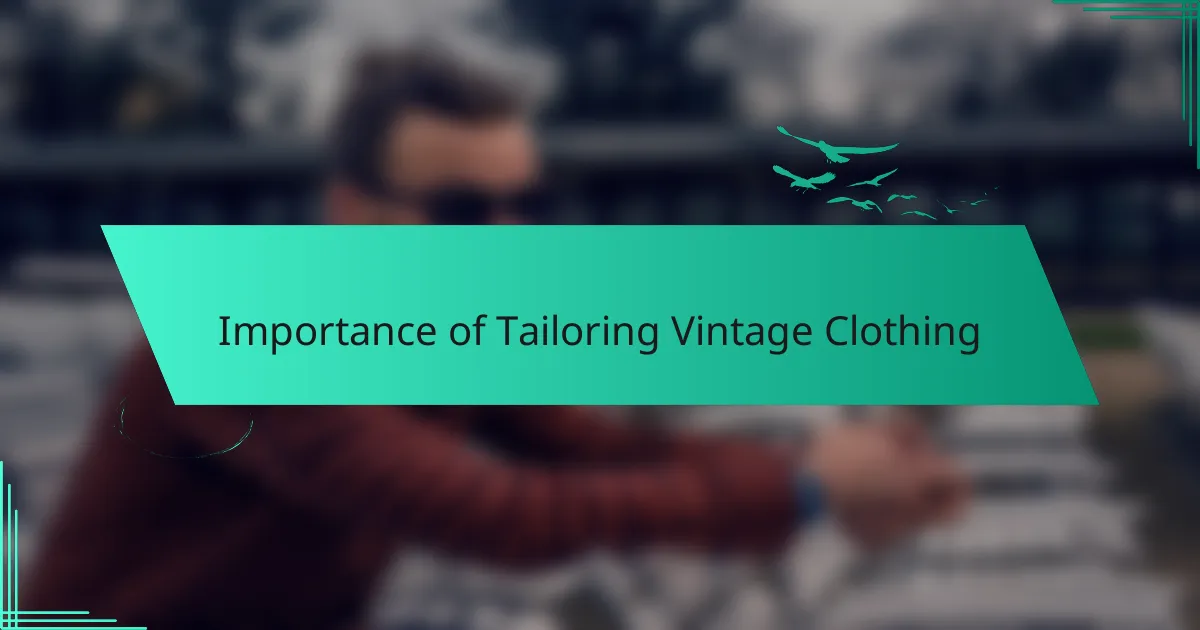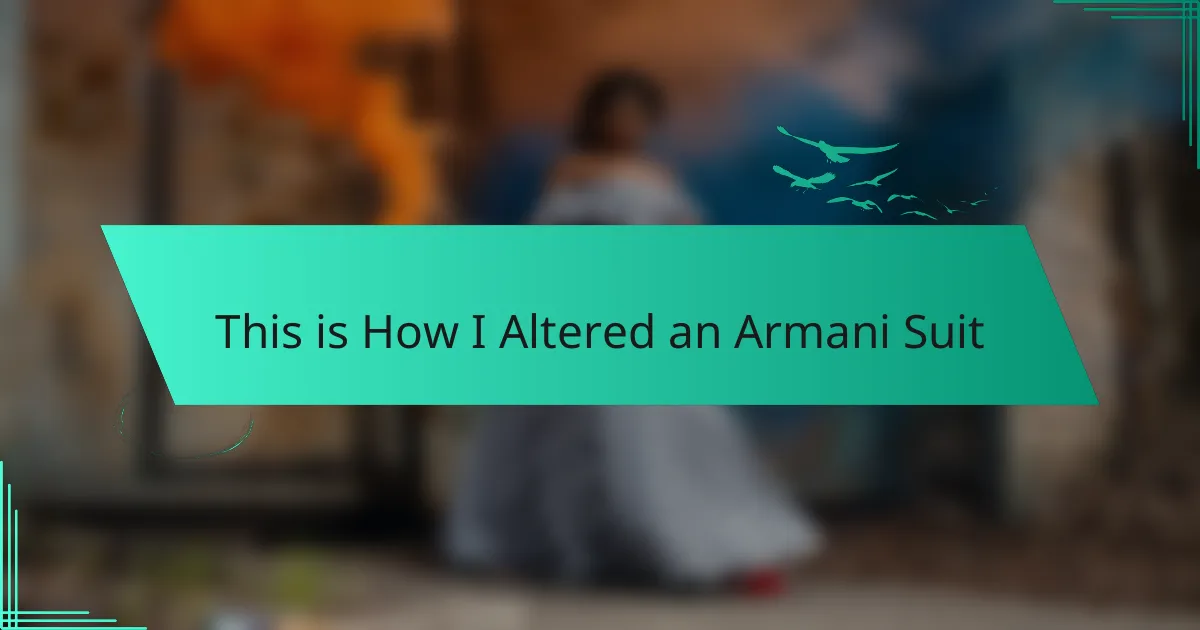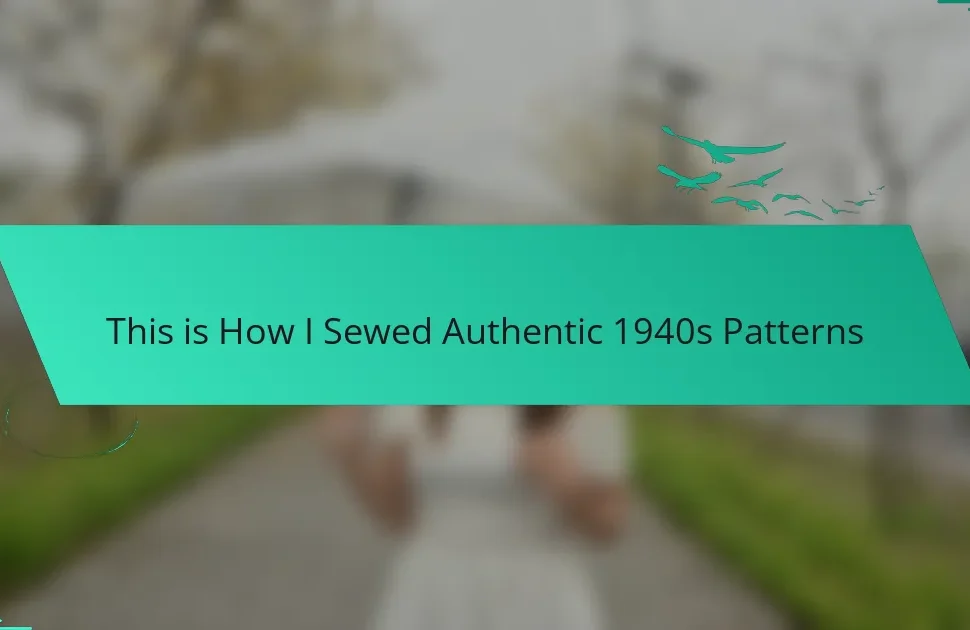Key takeaways
- Vintage fashion DIY allows for personal expression and a connection to fashion history through customization and tailoring.
- Tailoring vintage clothing enhances comfort and confidence, preserving the garment’s integrity while adding value to your wardrobe.
- Choosing the right suit for alteration involves assessing fabric quality, size, style, condition, and potential transformation.
- Successful suit customization requires attention to detail, patience, and the incorporation of personal touches to reflect individual style.

Understanding Vintage Fashion DIY
Understanding vintage fashion DIY is both exciting and rewarding. I’ve always felt that vintage pieces carry stories, and transforming them allows me to add my narrative. Every stitch, every alteration not only enhances the garment but also connects me deeply with fashion history—turning a simple suit into a unique statement.
In my experience, vintage DIY projects often teach you about the craftsmanship of the past. It’s incredible how one can appreciate the quality and detail that contemporary fast fashion often overlooks. I remember when I first altered an old Armani suit; it was like breathing new life into something timeless.
Here’s a comparison table that highlights vintage fashion DIY versus ready-to-wear clothing:
| Vintage Fashion DIY | Ready-to-Wear Clothing |
|---|---|
| Customization and personal expression | Limited choices in style |
| Connection to fashion history | Mass-produced and often lacking character |
| Learning about garment construction | No knowledge gained about craftsmanship |

Importance of Tailoring Vintage Clothing
When it comes to vintage fashion, tailoring is not just about fit; it’s about breathing new life into a piece with history. I remember when I got my hands on that vintage Armani suit; it had the elegance but the fit was all wrong for my frame. Altering it transformed the piece from just a relic into something that truly felt like mine, allowing me to showcase my style while honoring the craftsmanship.
Tailoring vintage clothing also ensures that you don’t compromise on comfort or confidence. There’s something undeniably empowering about wearing a suit that feels custom-made for you. Every stitch reflects your personal aesthetic, and it’s a joy to combine the past with the present in such a meaningful way.
Ultimately, well-tailored vintage pieces not only preserve the garment’s integrity but also add value to your wardrobe. Each alteration becomes a part of its story, making it a cherished addition that resonates with personal significance.
| Factor | Off-the-Rack |
|---|---|
| Tailored Vintage | Custom Fit |
| Unique Style | Common Trends |
| Emotional Connection | Generic Feel |

Choosing the Right Suit for Alteration
Choosing the right suit for alteration is crucial to achieving the perfect fit. I remember the first time I stumbled upon a vintage Armani suit at a thrift store. The fabric felt luxurious, but the fit was miles away from what I wanted. After a few hesitant thoughts, I took a leap and decided to buy it, knowing that a stellar alteration could transform it into something exceptional.
When selecting a suit for alteration, consider these key factors:
- Fabric Quality: Look for high-quality materials like wool or silk that hold up well during alterations.
- Size: Ensure the suit is close to your size. An oversized suit can be altered more easily than one that’s too small.
- Style: Pick a classic style that aligns with your personal aesthetic—this will ensure it remains timeless.
- Condition: Check for any damage or wear. Small imperfections can often be fixed, but significant damage might not be worth the effort.
- Potential: Visualize the final look. If you can see its potential in your wardrobe, it’s likely worth altering.
Taking these factors into account led me to successfully breathe new life into that Armani suit, which has since become one of my favorite pieces.

Essential Tools for Suit Alteration
When altering a suit, having the right tools at your disposal can make all the difference. From my experience, a simple sewing kit can be your best friend. It includes essentials like needles, thread, and scissors, which you’ll find yourself reaching for time and time again as you make those adjustments.
Here’s a brief list of recommended tools for your suit alteration project that I’ve found invaluable over the years:
- Sewing machine: For faster, professional-looking seams.
- Tailor’s chalk: Great for marking where adjustments need to be made.
- Measuring tape: To ensure precise measurements for a perfect fit.
- Seam ripper: Essential for removing stitches cleanly when needed.
- Iron and ironing board: Pressing after alterations creates a polished finish.
These tools belong to my DIY toolkit, and I can’t tell you how many times they’ve helped me transform a piece into something truly special!

Step by Step Alteration Process
When it comes to altering an Armani suit, the first step I always take is to try it on and pinpoint exactly what needs changing. This is where you truly connect with the garment. I often ask myself, “What do I want the final look to convey?” For my suit, I noticed the shoulders were a bit wide, and the sleeves were too long. Marking those areas with tailor’s chalk helped visualize the transformation ahead.
Next, I carefully made my measurements. This part can feel tedious, but trust me, it’s essential. I often find myself double-checking to ensure accuracy—it’s always better to measure twice and cut once! After marking the new seam lines, I gently remove the stitches using a seam ripper. There’s something oddly therapeutic about it, almost like unveiling the suit’s hidden potential with every careful pull.
Finally, it’s all about the sewing. I love the feeling of bringing the pieces together, almost like piecing together a puzzle. As I stitched, I could already see the suit taking shape. I always try it on again before finishing up to ensure everything aligns perfectly. There’s a unique thrill in seeing that transformation come to life! Each step not only alters the suit but also deepens my connection to it.

Personal Experiences with Suit Alteration
When I first tackled the alteration of my vintage Armani suit, it felt like an adventure filled with both excitement and trepidation. The moment I tried it on, I recall feeling an immediate disconnect; the fit was all wrong, but the fabric whispered promises of elegance. I often ask myself, “Can I really transform this into something that feels authentically me?” Taking that leap of faith was a decision born from the belief that this suit could tell a new story.
As I navigated the process of alteration, each adjustment felt like a dialogue between the past and my present style. I remember standing in front of the mirror, making small alterations and thinking how each stitch was my way of paying homage to its history while integrating my own flair. There was something absolutely thrilling about seeing the gradual change; it was like piecing together a puzzle that revealed a version of the suit that had been waiting to emerge.
I also learned that suit alterations are about more than just fit; they embody the thrill of creation. Each mark of the tailor’s chalk became a moment of reflection—a reminder that this suit was no longer just an old piece of clothing but rather a canvas for my interpretations of style. Have you ever modified a vintage piece? If so, you might relate to the satisfaction that comes from imbuing an item with your personal touch!

Tips for Successful Suit Customization
When customizing an Armani suit, I found it essential to focus on the fit. A great suit should feel like a second skin. I remember the first time I tried on my altered suit; it was like stepping into a new persona. Taking detailed measurements was key, so I recommend using a professional tailor if you’re unsure. It can save you both time and fabric.
Another tip is to think about the details. Adding personal touches like unique buttons or contrasting thread can elevate your suit from ordinary to extraordinary. I’ve added a splash of color to my cuffs, and every time I roll them up, I feel a burst of confidence. Experiment with fabrics for linings or pocket squares to create a look that reflects your personal style.
Lastly, take your time. Suit alteration isn’t a race. I rushed through my first customization and regretted some of my decisions. Now, I savor the process; each step is an opportunity to make the suit truly my own.
| Tip | Description |
|---|---|
| Fit | Ensure the suit fits well by taking accurate measurements, preferably with a tailor. |
| Details | Incorporate personal elements like buttons or thread color to make it uniquely yours. |
| Patience | Allow yourself time to customize and enjoy the transformation process. |




